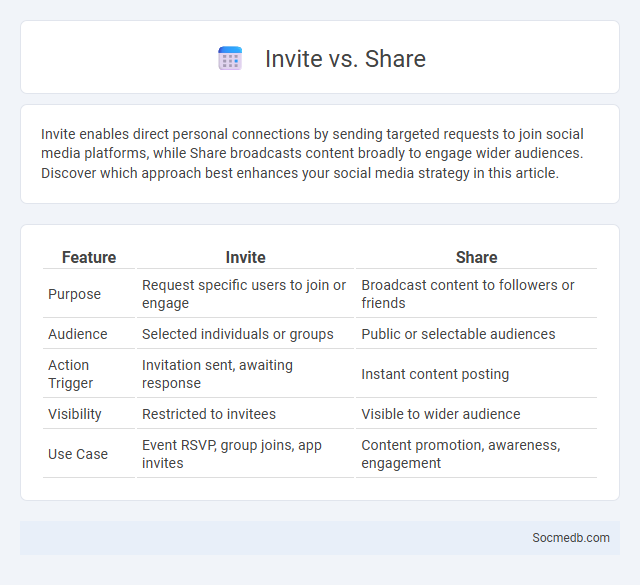
Photo illustration: Invite vs Share
Invite enables direct personal connections by sending targeted requests to join social media platforms, while Share broadcasts content broadly to engage wider audiences. Discover which approach best enhances your social media strategy in this article.
Table of Comparison
| Feature | Invite | Share |
|---|---|---|
| Purpose | Request specific users to join or engage | Broadcast content to followers or friends |
| Audience | Selected individuals or groups | Public or selectable audiences |
| Action Trigger | Invitation sent, awaiting response | Instant content posting |
| Visibility | Restricted to invitees | Visible to wider audience |
| Use Case | Event RSVP, group joins, app invites | Content promotion, awareness, engagement |
Understanding Invite, Share, and RSVP: Key Differences
Understanding the key differences between Invite, Share, and RSVP on social media enhances event engagement strategies by targeting audience interaction precisely. Invite functions allow users to directly request attendance, Share provides a method to broadcast event details broadly, and RSVP collects attendee confirmations for effective event planning. Mastery of these features drives higher participation rates and optimizes content reach.
What Does "Invite" Mean in Event Planning?
In event planning, "invite" refers to the formal request sent to potential attendees, typically through social media platforms, email, or event management tools, encouraging participation in a specific event. Effective invites include essential details such as date, time, location, and RSVP options to maximize guest engagement and attendance. Social media invites often leverage features like event pages and shareability to boost visibility and foster community interaction.
The Role of "Share" in Spreading the Word
The "Share" function acts as a catalyst in amplifying content reach across social media platforms, enabling users to redistribute posts to their own networks instantly. This feature leverages users' trust and relationships, turning individual endorsements into viral phenomena that boost brand visibility and message penetration. By facilitating exponential content dissemination, "Share" enhances organic growth, engagement metrics, and drives meaningful interactions on platforms like Facebook, Twitter, and Instagram.
RSVP: Definition and Importance
RSVP, short for "Repondez s'il vous plait," is a request for a response to confirm attendance at an event, crucial for effective social media event planning and management. It enables organizers to estimate guest numbers accurately, enhance engagement, and tailor content or logistics to audience preferences. Ensuring your social media RSVP strategy is clear and accessible maximizes attendance and improves overall event success.
When to Use Invite, Share, or RSVP
Use "Invite" when directly requesting someone's presence at an event, ensuring clear communication of the event details and expectations. Choose "Share" to distribute content broadly, enabling followers to spread information organically across platforms. Opt for "RSVP" to collect responses efficiently, streamlining event planning by confirming attendees in advance.
Pros and Cons of Inviting vs Sharing an Event
Inviting someone to a social media event creates a direct and personalized engagement, increasing the likelihood of attendance by targeting specific individuals. Sharing an event, however, broadens exposure by allowing content to circulate beyond initial contacts, potentially reaching a larger, more diverse audience. The downside of inviting is limited reach, while sharing may result in less control over attendee demographics and lower response rates.
The Impact of RSVP on Event Success
RSVP significantly enhances event success by providing accurate attendance estimates, enabling precise logistics and resource planning. Timely RSVP responses improve guest engagement and allow event organizers to tailor experiences to participant preferences. Data from RSVP trends also informs future marketing strategies and increases overall event ROI.
Common Mistakes: Invite, Share, and RSVP Misuse
Common mistakes in social media event management include misusing invitations by sending them to irrelevant audiences, which reduces engagement and event turnout. Sharing event details without clear calls to action often leads to confusion and low RSVP rates, undermining the event's success. Misinterpreting RSVP responses or failing to update event pages can result in poor planning and resource allocation for both organizers and attendees.
Best Practices for Inviting, Sharing, and RSVP Requests
Effective social media strategies for inviting, sharing, and RSVP requests center on clear, concise messaging paired with compelling visuals to boost engagement rates. Utilizing platform-specific features such as Instagram Stories' interactive polls, Facebook Event invites, and LinkedIn's event sharing options enhances visibility and user interaction. Incorporating direct call-to-actions and seamless RSVP links streamlines user response, increasing attendance and event success.
Choosing the Right Approach: Invite, Share, or RSVP?
Choosing the right social media approach depends on your event goals and audience engagement. Inviting lets you directly target specific users, increasing personalized connection, while sharing spreads awareness organically through your network. Your decision to use Invite, Share, or RSVP features influences participation rates and overall event success.
 socmedb.com
socmedb.com